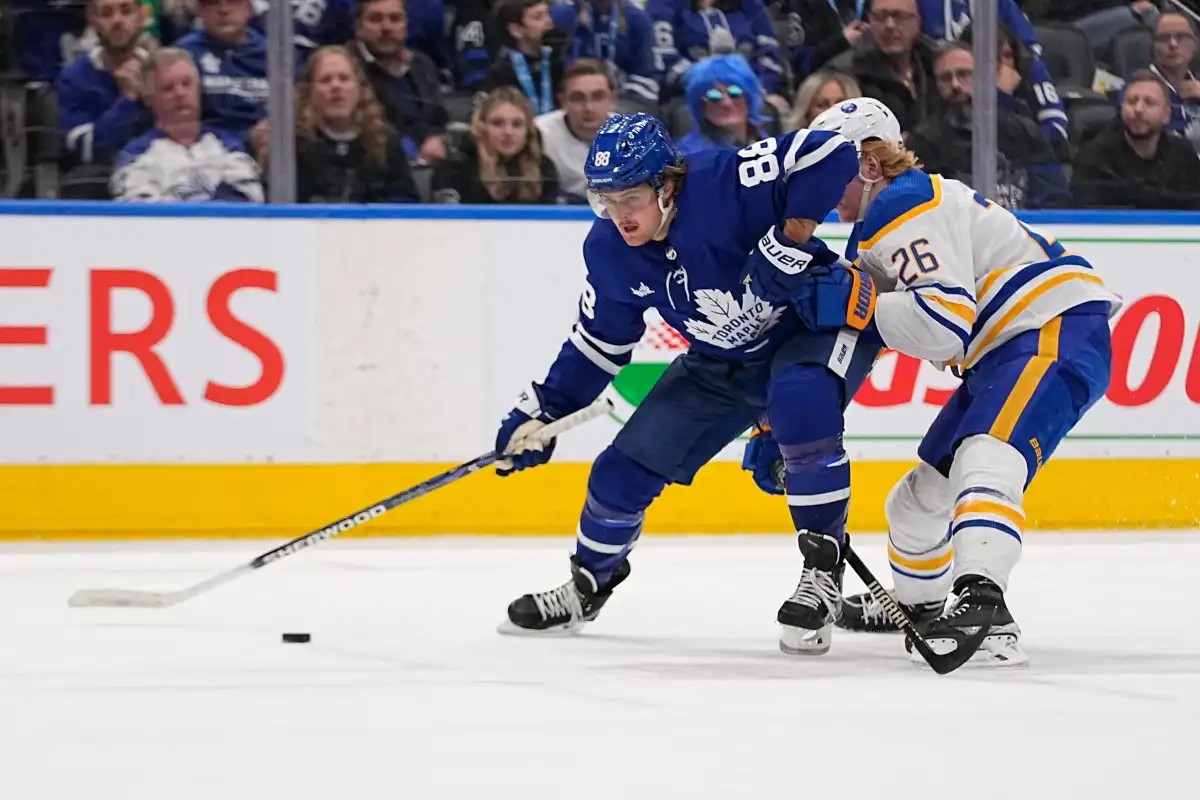The worst-kept secret in the league is out: On Monday, the Maple Leafs officially announced that they have come to terms with William Nylander on a mega deal totaling $92 million over eight years.
The contractual details are just as significant: Nylander is set to earn $69 million in signing bonuses, and he has full no-movement and no-trade protection for the entirety of the eight-year term, which is something that Nylander’s main comparable in negotiations, David Pastrnak, didn’t even receive.
As of today, the new contract gives Nylander the fifth-highest cap hit in the league next season (technically, Erik Karlsson has the same overall cap hit, but it is split across two teams). He will be one of the 10 highest-paid players in the NHL.
The Leafs’ big bet on Nylander and the comparables used
On the surface, it is a bit of a tough pill to swallow. Nylander has only been in the top-10 players-in-the-league territory for all of half of a season through his eight-year career to this point. But, with the salary cap limit set to increase notably over the next few seasons for really the first time in half a decade, it could push this contract way down the pecking order in short order. Just this past weekend, over at The Athletic, Thomas Drance noted that the Nylander negotiation will impact pending RFA Elias Pettersson:
“Probably the biggest impact from a comparables perspective on Pettersson negotiations from the widely expected Nylander deal is that it sets a floor, of sorts, in Pettersson talks. Unsurprisingly — given his age, production and the fact that he plays a premium position — Pettersson’s next deal, if it’s of similar term, should be expected to carry a higher annual average value than Nylander’s next contract.”
Now, it should be noted that Drance was working off of an $11.2 million or so contract assumption for Nylander, but nonetheless, if an RFA outearns Nylander in a few months from now, it stands to reason that it could be the tip of the iceberg. The following summer, all of Mikko Rantanen, Mitch Marner, and Leon Draisaitl are unrestricted free agents. Nylander will quickly fall out of the top 10, and not too long after, probably the top 15.
The Leafs are clearly banking on it from a cap-management perspective. Even with a rising cap, though, for Nylander to be worthy of his contract, he’s going to have to consistently produce as the 40-goal, 90+ point player he’s been since the start of last season (he’s obviously far outpacing those marks this season). If you want to take the glass-half-full view, there is at least some reason to think that he can produce like this consistently for years to come.
Nylander is actually posting his lowest shooting percentage in five seasons despite his giant numbers. He’s mainly playing more and shooting more. The Leafs have also started to use him a little bit differently, thereby perhaps capitalizing on his skillset more than in previous seasons. They regularly deploy him at the top of the blue line now on the power play and in 6v5 situations, using his shot as a weapon or to draw in defenders, creating extra space for Marner and Matthews to operate. It’s easy to forget that after the Leafs acquired Ryan O’Reilly last season, Nylander was the one taken off the top power-play unit.
Of course, the flip side is that Nylander is producing greater numbers than we’ve ever seen from him before as he is set to turn 28 in May. He would not be the first player to enjoy a contract year, and all of his stats are career highs – goals per game, assists per game, and points per game; all of those same stats again as /60 rates, and his shot and net-driving rates.
Visualized, it’s tough to ignore how much this season stands out as an outlier:
📈 Reportedly set to sign a fresh deal with #LeafsForever, WILLIAM NYLANDER has exploded in his age-27 season (tied for 5th in #NHL scoring).
The visual below is incredible & begs the question: A new gear from an all-world talent, or a fluke season?Can it be both? https://t.co/kkgyPNgsNQ pic.twitter.com/IYeiXps9Tw
— Paul Pidutti (@AdjustedHockey) January 7, 2024
Even if those numbers stabilize and settle in closer to last year’s production (the 40-goal, 90ish point range), I think Nylander will be worth the contract for at least the first half of the eight-year term while accounting for some level of decline afterward as the cap – and player salaries – rise over the coming seasons. Nylander is turning 28 on May 1, but the top scorer in the league right now, Nikita Kucherov, is turning 31 this summer. The third leading scorer, Artemi Panarin, is already 32. JT Miller, right behind Nylander in scoring, is turning 31 in a few months.
Complicating matters is that even if Nylander is worth this contractual commitment when it’s all said and done, the market does not exactly weigh this contract favourably. It’s difficult to wrap one’s head around the comparables that led the Leafs and Nylander to arrive at this number.
David Pastrnak, just like in the last negotiation, was used as a comparable, and while there are some arguments out there as to why it’s a good one, I have a hard time getting there. Pastrnak has generally outscored and outproduced Nylander over the entirety of their careers. Pastrnak is also the primary scoring forward on his team, while Nylander has been second, third, or even fourth at times. Again, even during this season after his torrid start, the opposition is still primarily matching all of their top defenders up against Auston Matthews – and for good reason as he’s the best goal scorer in the league.
Just this past offseason, Sebastian Aho, who is a year younger than Nylander and actually has a higher career-points-per-game output (not to mention he plays a premium position), signed for eight years at $9.75 million per season as a pending UFA. It’s hard to ignore how big the gap is between the two players salary-wise when the bottom line is that both bring very similar impacts when it comes to winning hockey games.
I’ve gone through my take on the proper comparisons multiple times, so I’m not going to rehash the same articles. I’ll just mention that I think Nylander has clearly been paid more than similar players, but he can also be worth the commitment if one buys that he has taken a legitimate, sustainable step forward in the past two or two-and-a-half seasons.
How dire is the Leafs’ cap situation with Nylander locked in at $11.5 million?
Nylander proving himself worthy of the money is one thing. Whether the team will have enough cap space left over to build a team capable of winning the Cup is another question altogether. Ultimately, that’s what this is really all about, isn’t it?
First and foremost, the Leafs couldn’t afford to lose Nylander either for free in the offseason or almost certainly by trade, either. Not only has he been one of the most productive players in the league this season, but he also has added penalty-killing duties to his responsibilities and is driving what has been, by and large, the Leafs’ best line this season. The team cannot replace Nylander’s contributions in any sort of trade or internal promotion.
It’s difficult to even put together what a possible trade might have looked like. The last similar-ish player to be moved ahead of free agency is likely Mark Stone, who was traded as a pending UFA at age 26. Now, Nylander is clearly more talented than Stone, but Stone isn’t exactly a slouch. He is a top-line winger who just captained his team to the Stanley Cup. In return, Ottawa received Oscar Lindberg, Erik Brannstrom (who was a highly-touted prospect at the time), and a second-round pick in the 2020 draft.
This type of trade would set the Leafs back years, at minimum. Even with the freed-up cap space to sign other players, the idea of losing a star to add two – or maybe even three – quality players to create depth falls in the “careful what you wish for” territory.
Nylander is a legitimate star and has led the Leafs to a collection of wins this season almost single-handedly at times. Add in that he has generally performed well in the playoffs when the chips are down, and it’s tough to argue that Toronto would be better off trading him for pennies on the dollar before repurposing their cap space on lower-tier players.
The Leafs also just invested huge dollars in Auston Matthews, who is in the middle of his prime and is once again leading the league in goals. The contention window is part of the equation here. They are trying to win now, and Nylander is part of the solution.
Looking at the cap situation, I’m also not convinced this is some sort of death sentence for the Maple Leafs. Looking ahead quickly to next season, the Leafs have the following players under contract:
Knies – Matthews – Marner
Tavares – Nylander
Jarnkrok
Holmberg – Kampf
Rielly
McCabe
Timmins
Woll
They’ll have a little over $23 million in cap space provided they do the right thing with Ryan Reaves (more on that in a second). Notable RFAs under team control include Nick Robertson and Noah Gregor at forward, and Timothy Liljegren and Simon Benoit on defense. Simply signing those four players would fill up half of their eight available roster spots, and as RFAs, the Leafs should be able to sign all of them to favourable deals (Liljegren could see some notable money thrown his way, though). If any rookies crack the lineup full-time to start the season, it’s gravy.
The Leafs wouldn’t necessarily need to strictly limit themselves to bargain shopping in this situation. They would, hypothetically, have enough cap space to retain a player like Tyler Bertuzzi and capably fill out the rest of their roster. Players like Knies and Woll each making under $1 million provides them with real flexibility, to say nothing of Jake McCabe’s $2 million.
Undoubtedly, though, Brad Treliving is going to need to be a lot more prudent in how he uses his available dollars going forward. Giving Ryan Reaves over $1.3 million per season and shedding Sam Lafferty isn’t going to suffice. He can’t take a flyer on a John Klingberg type either, hoping he’ll be the player he was some three-plus seasons ago.
Treliving has made some good bets and signings, to be clear, but those were notable mistakes or gambles from the outset that he can’t afford when the dollars tighten up. Seeing as next season is the last of Tavares’ deal, 2024-25 is going to be the tightest season to navigate. Even then, we can look at the framework of the roster and picture how it’s not exactly difficult to fill out the team with the available dollars and roster spots, which is now easier to do because five of the top six forward spots are accounted for.
The bottom line
Ultimately, the deal is a little rich based on the current market, but it’s tough to argue that the Leafs would be better off without Nylander or that their cap situation is so dire moving forward that it will further prohibit them from winning, either.
The big question is really whether Nylander’s recent play – or something close to it – is who Nylander really is going forward. If he’s even roughly this impactful, the Leafs should be contenders for years to come.
Of course, the alternative scenario involving a return closer to career averages would be a real problem for the team to navigate.



































